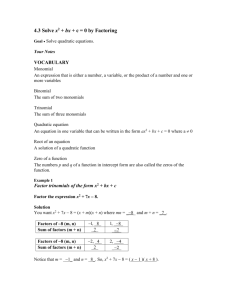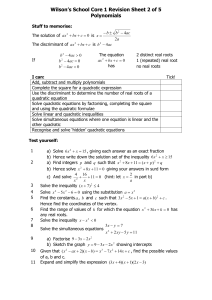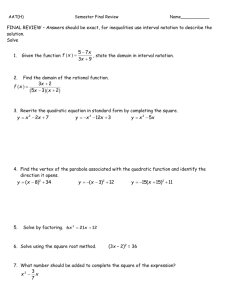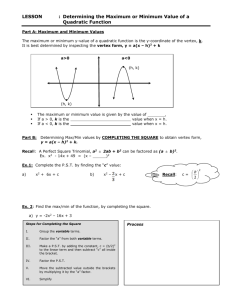Unit 4: Quadratic Functions Name
advertisement
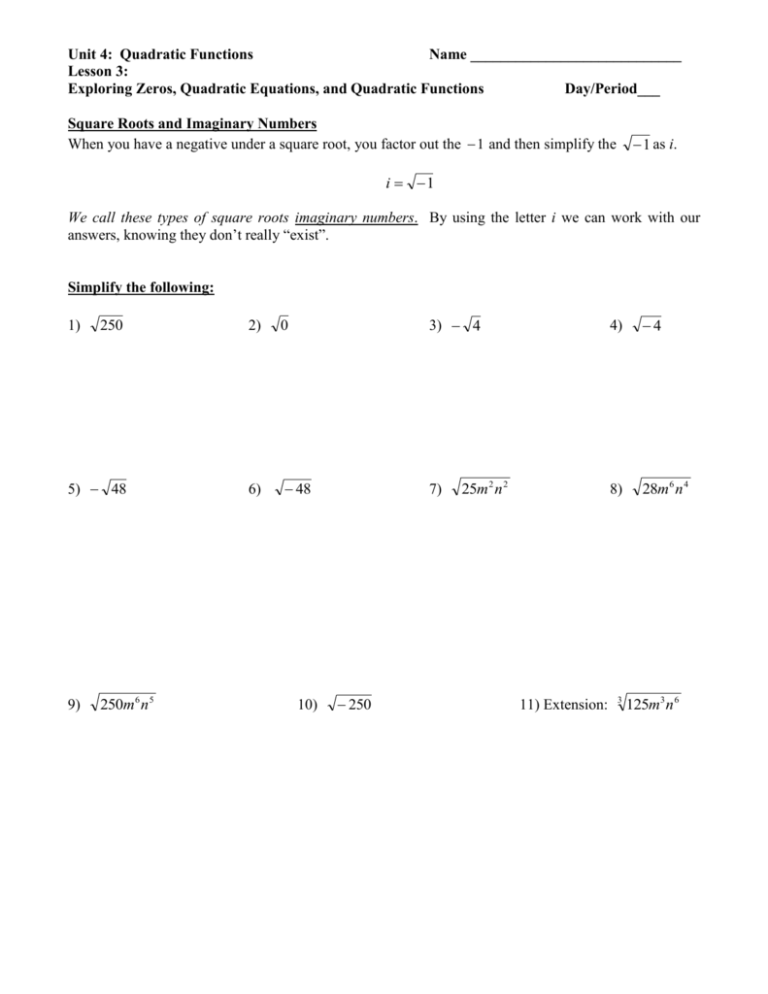
Unit 4: Quadratic Functions Name ____________________________ Lesson 3: Exploring Zeros, Quadratic Equations, and Quadratic Functions Day/Period___ Square Roots and Imaginary Numbers When you have a negative under a square root, you factor out the 1 and then simplify the 1 as i. i 1 We call these types of square roots imaginary numbers. By using the letter i we can work with our answers, knowing they don’t really “exist”. Simplify the following: 250 2) 0 3) 4 5) 48 6) 48 7) 1) 9) 250m 6 n 5 10) 250 25m 2 n 2 11) Extension: 4) 4 8) 28m 6 n 4 3 125m3 n 6 TYPES of ZEROS When we graph quadratic functions we get a parabola. Depending on where the graph is located, we may see two, one, or NO zeros at all. For each of the following, find the zeros using the quadratic formula. Give both exact and decimal solutions if the answers are irrational. 1) y 6 x 2 9 x 6 2) y 3x 2 12 x 12 What is the value of the discriminant? _____ What is value of the discriminant? _____ Zeros are _______________________ Zeros are ______________________. 3) y 3x 2 4) y x 2 5 x 9 What is the value of the discriminant? _____ What is the value of the discriminant? _____ Zeros are _______________________ Zeros are _______________________ 5) y x 2 4 x 8 6) y 3x 2 12 x 16 What is the value of the discriminant? _____ What is the value of the discriminant? _____ Zeros are _______________________ Zeros are _______________________ Summary: The Discriminant If the value b 2 4ac 0 there will be _____ real solutions. If b 2 4ac is a perfect square, the two solutions will be _____________________ If b 2 4ac is NOT a perfect square, the two solutions will be _____________________ If the value b 2 4ac 0 there will be _____ real solutions but both solutions will be ______________. If the value b 2 4ac 0 there will be _____ IMAGINARY solutions. Note: If the solutions are RATIONAL, then the quadratic equation could have also been factored to solve it! Question: For which of the problem(s) from #1-6 could we have ALSO used the zero-product property to find the zeros? Use factoring to find the zeros again from problems # ___________________: Extension Vocabulary: “Roots” are answers to equations that are set equal to zero. Identify a, b, and c and find the Discriminant. Solve using the Quadratic formula. Simplify all radicals completely and find both exact and decimal answers. 1) 0 2 x 2 3x 5 2) 3x 2 5 x 1 0 3) x 2 6x 4 0 4) 0 x 2 2 x 7 5) 0 2x 2 4x 6 6) 6 x 2 x 2 0 5 13 6 1 i 2 2 1 , 3 2 1 2 2 5 1, 2 3 5 Which problems above could have been solved using factoring and the zero-product property instead?


